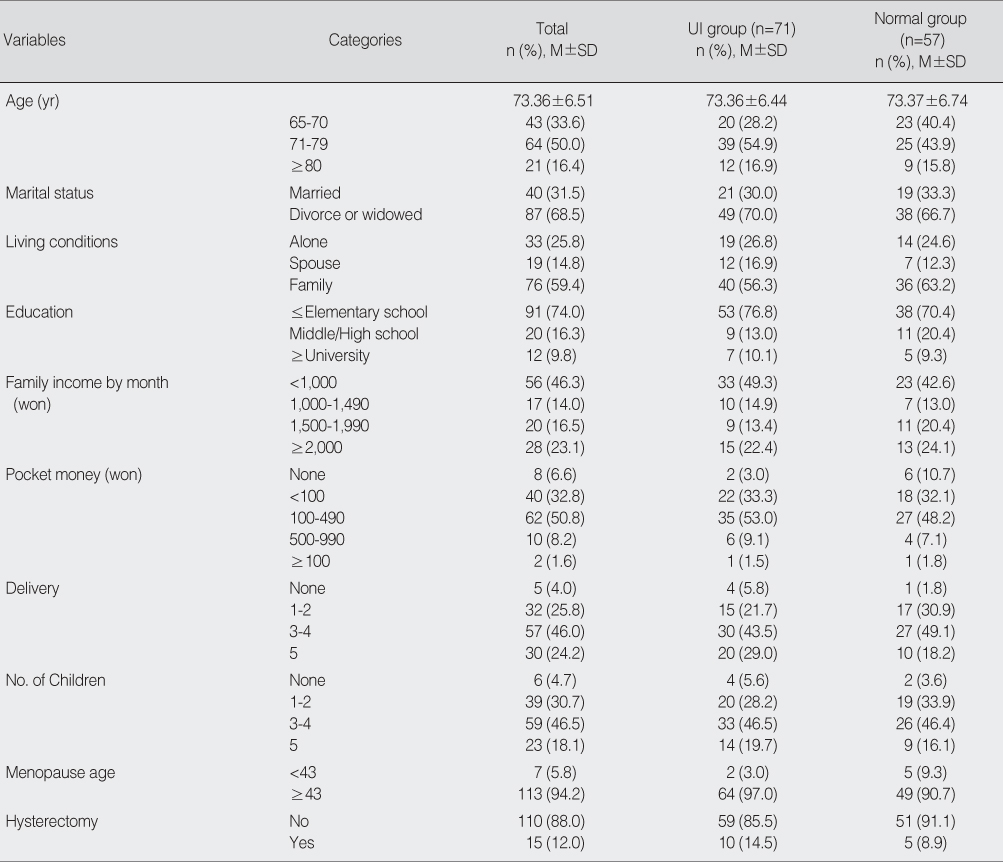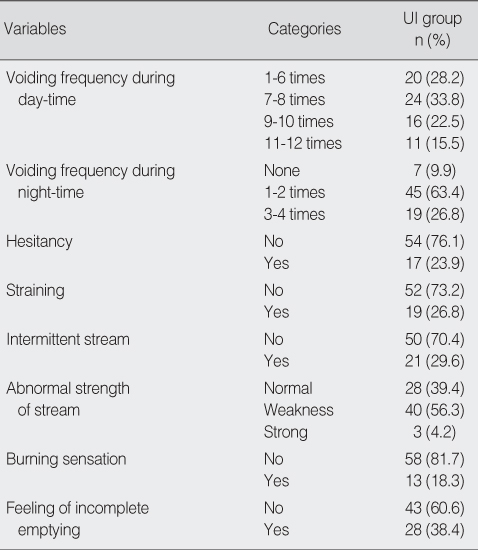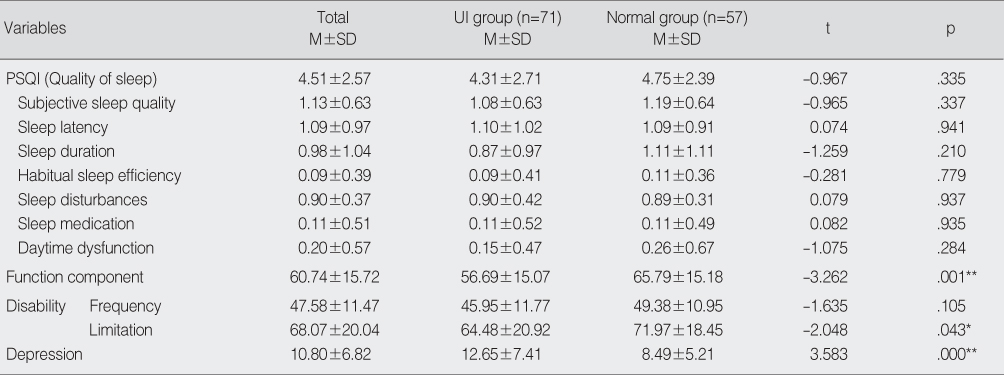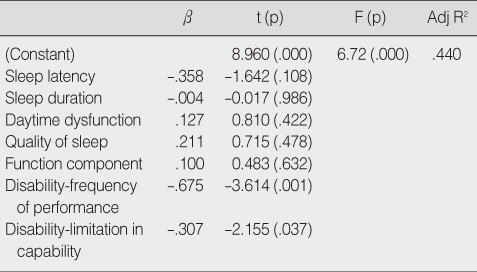Articles
- Page Path
- HOME > J Korean Acad Nurs > Volume 38(4); 2008 > Article
-
Original Article
- The Relationship of Quality of Sleep, Depression, Late-Life Function and Disability (LLFDI) in Community-Dwelling Older Women with Urinary Incontinence
- Kyung Rim Shin, Younhee Kang, Jiwon Oak
-
Journal of Korean Academy of Nursing 2008;38(4):573-581.
DOI: https://doi.org/10.4040/jkan.2008.38.4.573
Published online: August 31, 2008
1Professor, College of Nursing Science, Ewha Womans University, Seoul, Korea.
2Assistant Professor, College of Nursing Science, Ewha Womans University, Seoul, Korea.
3Post-doc Fellow, College of Nursing Science, Ewha Womans University, Seoul, Korea.
- Address reprint requests to: Shin, Kyung-Rim. College of Nursing Science, Ewha Womans University, 11-1 Daehyeon-dong, Seodaemun-gu, Seoul 120-750, Korea. Tel: 82-2-3277-2886, Fax: 82-2-3277-2850, krshin@ewha.ac.kr
Copyright © 2008 Korean Society of Nursing Science
Abstract
-
Purpose
- The purpose of this study was to investigate the relationships among quality of sleep, depression, late-life function and disability in community-dwelling older women with urinary incontinence.
-
Methods
- A stratified random sampling method was conducted to recruit participants from May 10 to August 17, 2007. Data were collected by questionnaires, which were constructed to include lower urinary tract symptoms, quality of sleep, depression, and late-life function and disability in 128 community-dwelling older women.
-
Results
- The major findings of this study were as follow: 1) 56.3% of participants belonged to urinary incontinence group. 2) There were significant relationships between depression and sleep latency, sleep duration, daytime dysfunction, quality of sleep, function component, frequency dimension, and limitation dimension. 3) Depression was significantly associated with frequency dimension, limitation dimension in capability which explained 44% of variance in depression.
-
Conclusion
- These results may contribute to a better understanding of sleep quality, depression, late-life function and disability in the community-dwelling older women with urinary incontinence. Therefore, health programs for prompting older women's health should be planned based on results of the study.
- 1. Abrams P, Cardozo L, Fall M, Griffiths D, Rosier P, Ulmsten U, et al. The standardisation of terminology in lower urinary tract function: Report from the standardisation sub-committeeof the International Continence Society. Urology. 2003;61:37–49.ArticlePubMed
- 2. Anger JT, Saigal CS, Litwin MS. Urologic Diseases of America Project. The prevalence of urinary incontinence among community dwelling adult women: Results from the National Health and Nutrition Examination Survey. The Journal of Urology. 2006;175:601–604.Article
- 3. Buysse DJ, Reynolds CF 3rd, Monk TH, Berman SR, Kupfer DJ. The Pittsburgh Sleep Quality Index: A new instrument for psychiatric practice and research. Psychiatry Research. 1989;28:193–213.ArticlePubMed
- 4. Choo MS, Ku JH, Oh SJ, Lee KS, Paick JS, Seo JT, et al. Prevalence of urinary incontinence in Korean women: An epidemiologic survey. International Urogynecology Journal and Pelvic Floor Dysfunction. 2007;18:1309–1315.PubMed
- 5. Dawson C, Whitfield H. ABC of urology. Bladder outflow obstruction. British Medical Journal. 1996;312:767–770.ArticlePubMedPMC
- 6. Haley SM, Jette AM, Coster WJ, Kooyoomjian JT, Levenson S, Heeren T, et al. Late life function and disability instrument: II. Development and evaluation of the function component. The Journals of Gerontology. 2002;57:M217–M222. Series A, Biological Sciences and Medical Sciences.ArticlePubMed
- 7. Jackson S, Donovan J, Brookes S, Eckford S, Swithinbank L, Abrams P. The Bristol Female Low Urinary Tract Symptoms questionnaire: Development and psychometric testing. British Journal of Urology. 1996;77:805–812.ArticlePubMed
- 8. Jette AM, Haley SM, Coster WJ, Kooyoomjian JT, Levenson S, Heeren T, et al. Late life function and disability instrument: I. Development and evaluation of the disability component. The Journals of Gerontology. 2002;57:209–216. Series A, Biological Sciences and Medical Sciences.
- 9. Jung IK, Kwak DI, Joe SH, Lee HS. A study of standardization of Korean Form of Geriatric Depression Scale. Journal of Korean Geriatric Psychiatry. 1997;1:61–72.
- 10. Kim JI. Prevalence of urinary incontinence and other urologic symptoms in a community residing elderly people. Journal of Korean Academy of Nursing. 2002;32:28–39.ArticlePDF
- 11. Kim KH. Study on correlation between urinary Incontinence & lower urinary tract symptom and daily life of middle-aged & elderly women in urban city. 2002;Seoul, Ewha Womans University. Unpublished master's thesis.
- 12. Kim KH, Park HJ, Jin YH, Kang YH, Shin KR. The correlation among quality of life, depression, and urinary incontinence of elderly women in a urban city. Journal of the Korean Geriatrics Society. 2007;27:943–962.
- 13. Kim MS, Lee SH. Prevalence rate and associated factors of urinary incontinence among nursing home residents. Journal of Korean Academy of Nursing. 2008;38:92–100.ArticlePubMed
- 14. Lee HJ, Jo KH. Type of college students attitude toward elderly suicide. Journal of Korean Association of Welfare for the Aged. 2006;34:293–311.
- 15. Lee MJ. A study on urinary incontinence and sleep disorder, quality of life of elderly women. 2007;Seoul, Ewha Womans University. Unpublished master's thesis.
- 16. Lekan-Rutledge D. Urinary incontinence strategies for frail elderly women. Journal of Urological Nursing. 2004;24:281–301.
- 17. MacDonald CD, Butler L. Silent no more: Elderly women's stories of living with urinary incontinence in long-term care. Journal of Gerontological Nursing. 2007;33:14–20.Article
- 18. Melville JL, Delaney K, Newton K, Katon W. Incontinence severity and major depression in incontinent women. Obstetrics & Gynecology. 2005;106:585–592.Article
- 19. Milsom I. The prevalence of urinary incontinence. Acta Obstetricia et Gynecologica Scandinavica. 2000;79:1056–1059.ArticlePubMed
- 20. Montgomery P, Dennis J. Physical exercise for sleep problems in adults aged 60+. Cochrane Database of Systematic Reviews. 2002;4:CD003404.
- 21. Oh YH, Bae HO, Kim YS. A study on physical and mental function affecting self-perceived health of older persons in Korea. Journal of the Korean Geriatrics Society. 2006;26:461–476.
- 22. Park YH, Suh EE. The risk of malnutrition, depression, and the perceived health status of older adults. Journal of Korean Academy of Nursing. 2007;37:941–948.ArticlePubMedPDF
- 23. Pilcher JJ, Ginter DR, Sadowsky B. Sleep quality versus sleep quantity: Relationship between sleep and measures of health, well-being and sleepiness in college students. Journal of Psychosomatic Research. 1997;42:583–596.ArticlePubMed
- 24. Segulin N, Deponte A. The evaluation of depression in the elderly: A modification of the Geriatric Depression Scale (GDS). Archives of Gerontology and Geriatrics. 2007;44:105–112.Article
- 25. Shin KL, Kim MY. The relationship between cognitive function and depression in a Korean island elderly. Journal of Korean Gerontological Nursing. 2001;3:32–41.
- 26. Woo KM. Effects of exercise-motivation program for the elderly women. 2003;Busan, Kosin University. Unpublished doctoral dissertation.
- 27. Wyman JF. Treatment of urinary incontinence in men and older women: The evidence shows the efficacy of a variety of a techniques. The American Journal of Nursing. 2003;103:Suppl. 26–35.
- 28. Yesavage JA, Brink TL, Rose TL, Lum O, Huang V, Adey M, et al. Development and validation of a geriatric depression screening scale: A preliminary report. Journal of Psychiatric Research. 1983;17:37–49.Article
- 29. Youn JH. A study on IBS and stress perceived by college women and their dietary habit and sleeping quality. 2005;Seoul, Ewha Womans University. Unpublished master's thesis.
- 30. Yu MK. A study on the sleep in the community dwelling elderly. 2007;Seoul, Ewha Womans University. Unpublished master's thesis.
REFERENCES
Figure & Data
REFERENCES
Citations

- The Effect of White Noise on Sleep in Hospitalized Patients: A Randomized Controlled Trial
Min-Eun Cho, Sun-Kyung Hwang
Korean Journal of Adult Nursing.2021; 33(1): 44. CrossRef - Structural Equation Modeling on Quality of Life in Middle-Aged Women with Urinary Incontinence
Young Ran Yeom, Aekyung Kim
Journal of Korean Academy of Fundamentals of Nursing.2021; 28(1): 43. CrossRef - Factors Affecting Sleep Disturbances in Hospitalized Patients with Colorectal Cancer undergoing Chemotherapy: A Retrospective Study
Jihyeon Song, Smi Choi-kwon
Korean Journal of Adult Nursing.2019; 31(1): 100. CrossRef - Effect of Pila-dance to Ease Urinary Incontinence of Middle-aged Women
Hye-Jeon Hong
The Korean Journal of Physical Education.2018; 57(2): 431. CrossRef - Development and Effects of Early Exercise Program for Lumbar Spine Surgery Patients
Geun Jin Kim, Hye Young Kim
Korean Journal of Adult Nursing.2018; 30(3): 245. CrossRef - What affects the subjective sleep quality of hospitalized elderly patients?
Mi Jeong Park, Kon Hee Kim
Geriatrics & Gerontology International.2017; 17(3): 471. CrossRef - The Effect of an Exercise Program for Preventing Urinary Incontinence among Community-Dwelling Elderly Females Living Alone
Mi Sook Song, Sunjoo Boo
Journal of Korean Public Health Nursing.2016; 30(2): 247. CrossRef - Health-related quality of life and mental health in older women with urinary incontinence
YeunHee Kwak, HaeJin Kwon, YoonJung Kim
Aging & Mental Health.2016; 20(7): 719. CrossRef - Sleep Disorder Experience in Older Patients with Depression
Seong-Sook Jun, Su-Jung Ha
Journal of Korean Academy of Nursing.2014; 44(3): 270. CrossRef - A Study on Urinary Incontinence Related Health Problems in Women above Middle Age in Rural Areas and Their Coping with the Problems
Chunmi Kim, Hung Sa Lee, Eun Man Kim
Journal of Korean Academy of Community Health Nursing.2013; 24(3): 368. CrossRef - Prevalence of urinary incontinence in older Korean women
Aeyoung So, Jennie C De Gagné, Mary H Palmer
International Journal of Urological Nursing.2012; 6(2): 51. CrossRef - Factors related to the Quality of Sleep in the Elderly Women
Young-Hee Kim, Jin-Sook Han
Journal of the Korea Academia-Industrial cooperation Society.2011; 12(10): 4467. CrossRef
Characteristics related Urinary Incontinence of Subjects (N=128)
General Characteristics of Urinary Incontinence and Normal Group (N=128)
Missing data excluded. UI=urinary incontinence.
Lower Urinary Tract Symptoms in Urinary Incontinence Group (N=71)
Comparison of Quality of Sleep, Late-Life FDI, and Depression between Urinary Incontinence and Normal Group (N=128)
Missing data excluded.
Relationships among the Characteristics in Urinary Incontinence Group (N=71)
Effects of Study Variables on Depression in Urinary Incontinence Group (N=71)
Missing data excluded. UI=urinary incontinence.
Missing data excluded.
 KSNS
KSNS
 E-SUBMISSION
E-SUBMISSION






 Cite
Cite

